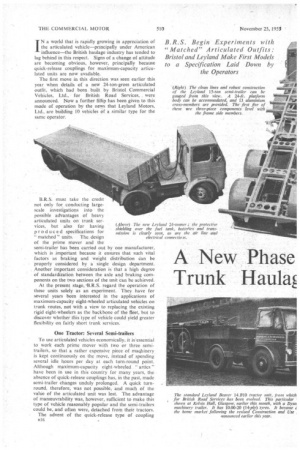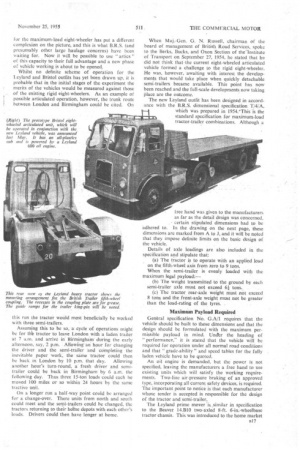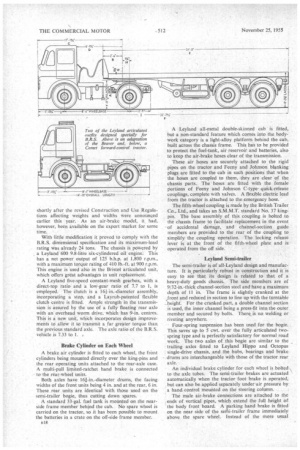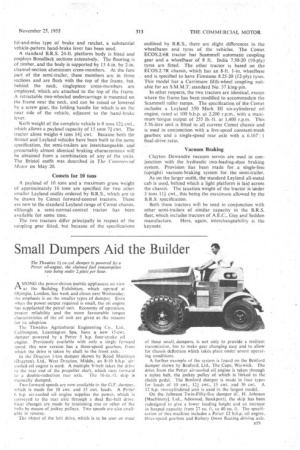A New Phase Trunk Haulal
Page 50

Page 51

Page 52

Page 53

If you've noticed an error in this article please click here to report it so we can fix it.
IN a world that is rapidly growing in appreciation of the articulated vehicle—principally under American influence—the British haulage industry has tended to lag behind in this respect. Signs of a change of attitude are becoming obvious, however, principally because quick-release couplings for maximum-capacity articulated units are now available.
The first move in this direation was seen earlier this year when details of a new 24-ton-gross articulated outfit, which had been built by Bristol Commercial Vehicles, Ltd., for British Road Services, . were announced. Now a further fillip has been given to this mode of operation by the news that Leyland Motors, Ltd., are building 10 vehicles of a similar type for the same operator.
B.R.S. must take the credit not only for conducting largescale investigations into the possible advantages of heavy articulated units on trunk services, but also for having produced specifications for " matched " units. The design of the prime mover and the semi-trailer has been carried out by one manufacturer, which is important because it ensure § that such vital factors as braking and weight distribution Can be properly considered by a single design department. Another important consideration is that a high degree of standardization between. the axle and braking components on the two sections of the unit can be achieved.
At the present stage, -"I.R.S. regard the operation of these units solely as an experiment. They have for several years been interested in the applications of maximum-capacity eight-wheeled articulated-vehicles on trunk routes, not with a view to replacing the existing rigid eight-wheelers as the backbone of the fleet,' but to discover whether this type of vehicle could yield greater flexibility on fairly short trunk services.
One Tractor: Several Semi-trailers To use articulated vehicles economically,it isessential to work each prime mover with two or three semitrailer's,so that a rather expensive piece of maghinery is kept continuously on the move, instead of spending several idle hours per day at each turn-round point. Although maximum-capacity eight-wheeled " artics " have been in use in this country for many years, the absence of quick-release couplings has, in the past, made semi-trailer changes unduly prolonged. A quick turnrourtd, therefore, was not possible, and much of the value of the articulated unit was lost. The advantage of manceuvribility was, however, sufficient to make this type of vehicle reasonably popular and the semi-trailers could be, and often were, detached from their tractors.
The advent of the quick-release type of coupling for the maximum-load eight-wheeler has put a different complexion on the picture, and this is what B.R.S. (and presumably other large haulage concerns) have been waiting for. Now it will be possible to use " artics " of this capacity to their full advantage and a new phase of vehicle working is about to be opened.
Whilst no definite scheme of operation for the Leyland and Bristol outfits has yet been drawn up, it is probable that in the initial stages of the experiment the merits of the vehicles would be measured against those of the existing rigid eight-wheelers. As an example of possible articulated operation, however, the trunk route between London and Birmingham could be cited. On this run the tractor would most beneficially be worked with three semi-trailers.
Assuming this to be so; a cycle of operations might be for thV. tractor to leave London with a laden trailer at 7 a.m. and arrive in Biriningharn" during the early afternoon, say, 2 p.m. Allowing an hour for Changing the driver and the semi-trailer and -Completing the inevitable paper work, the same tractor could• then be back in London by 10 p.m. that day. Allowing another hour's turn-round, a" fresh driver and semitrailer could be back in BirMingham. by 6 a.m. the following day. Thus three 15-ton loads could each be moved 100 miles or so within 24 hours by the same
tractive unit.
On a longer run a half-way point could be arranged for a change-over. There units from north and south could meet and the semi-trailers could be changed, the tractors returning to their holm depots with each other's loads. Drivers could then have longer at home. When Maj.-Gen. G. N. Russell, chairman of the board of management of British Road Services, spoke to the Berks, Bucks, and Oxon Section of the institute of Transport on September 27, 1954, he stated that he did not think that the current eight-wheeled articulated vehicle formed a challenge to the rigid eight-wheeler. He was, however, 'awaiting with interest the developments that would take place when quickly detachable semi-trailers became available. This point has now been reached and the full-scale developments now taking Place are the outcome.
The new Leyland outfit has been designed in accordance with the B.R.S. dimensional specification T/4/A, which was prepared in 1954.•This is the standard specification for maximum-load tractor-trailer combinations. Although a free hand was given to the manufacturers as far as the detail design was concerned, , • certain stipulated dimensions had to be adhered to. In the drawing on the next page, these dimensions are marked from A to .1, and it will be noted that they impose definite limits on the basic design of the vehicle.
Details of axle loadings are also included in the specification and stipulate that:
. (a) The tractor 4 to operate with an applied load on the fifth-wheel axis from zero to 9 tons.
When the semi-trailer is evenly loaded with the maximum legal payload:— (b) The weight transmitted to the ground by each semi-trailer axle must not exceed 61 tons.. .
(c) The tractor rear-axle weight must not exceed 8 tons and the front-axle weight must not be greater than the load-rating of the tyres. .
Maximum 'Payload Required
Gentral specification No. GA/1 requires that the vehicle should be built to those dimensions and that the design should be formulated with the maximum permissible payload in mind. Under the heading oE " performance," it is stated that the vehicle will be required for operation under all normal road conditions and that " grade-ability " and speed tables for the fully laden vehicle have to be quoted.
An oil engine is demanded, but the power is not specified, leaving the manufacturers a free hand to use existing units which will satisfy the working requirements. Two-line air-pressure braking of an approved type, incorporating all current safety devices, is required. The important point to notice is that each manufacturer whose tender is accepted is responsible for the design of the tractor and semi-trailer.
The Leyland prime mover is ,similar in specification to the Beaver 14.810 two-axled 8-ft. 6-in.-wheelbase tractor chassis, This was introduced to the home market nil shortly after the revised Construction and Use Regulations affecting weights and widths were announced earlier, this year. As an air-brake model, it had, however, been available on the export market for some time.
With little modification it proved to comply with the B.R.S. dimensional specification and its maximum-load rating was already 24 tons. The chassis is powered by a Leyland 600 9.8-litre six-cylindered oil engine. This has a net power output of 125 b.h.p. at 1,800 r.p.m., with a maximum torque rating of 410 lb.-ft. at 900 r.p.m. This engine is used also in the Bristol articulated unit, which offers great advantages in unit replacement.
A Leyland five-speed constant-mesh gearbox, with a direct-top ratio and a low-gear ratio of 7.7 to 1, is employed. The clutch is a 161-in.-diameter assembly, incorporating a stop, and a Layrub-patented flexible clutch centre is fitted. Ample strength in the transmission is assured by the use of a fully floating rear axle with an overhead worm drive, which has 9-in. centres. This is a new unit, which incorporates design improvements to allow it to transmit a far greater torque than the previous standard axle. The axle ratio of the B.R.S. vehicle is 7.33 to I.
Brake Cylinder on Each Wheel
A brake air cylinder is fitted to each wheel, the frnnt cylinders being mounted directly over the king-pins and the rear operating units attached to the rear-axle case. A multi-pull limited-ratchet hand brake is connected to the rear-wheel units.
Both axles have 161-in.-diameter drums, the facing widths of the front units being 4 in. and at the rear, 6 in. These rear units are identical with those used on the semi-trailer bogie, thus cutting down spares.
A standard 33-gal. fuel tank is mounted on the nearside frame member behind the cab. No spare wheel is carried on the tractor, so it has been possible to mount the batteries in a crate on the off-side frame member. A Leyland all-metal double-skinned cab is fitted, but a non-standard feature which comes into the bodywork category is a light-alloy platform behind the cab, built across the chassis frame. This has to he provided to protect the fuel-tank, air reservoir and batteries, also to keep the air-brake hoses clear of the transmission.
These air hoses are securely attached to the rigid pipes on the tractor and Feeny and Johnson blanking plugs are fitted to the cab in such positions that when the hoses are coupled to them, they are clear of the chassis parts. The hoses are fitted with the female portions of Feeny and Johnson C-typequick-release couplings, complete with valves. A flexible electric lead from the tractor is attached to the emergency hose.
The fifth-wheel coupling is made by the British Trailer Co., Ltd., and takes an S.M.M.T. standard No. 37 kingpin. The base assembly of this coupling is bolted to the chassis frame to facilitate replacement in the event of accidental damage, and channel-section guide members are provided to the rear of the coupling to simplify the coupling operation. The locking release lever is at the front of the fifth-wheel plate and is operated from the off side.
Leyland Semi-trailer
The semi-trailer is of all-Leyland design and manufacture. It is particularly robust in construction and it is easy to see that its design is related to that of a heavy-duty goods chassis. The side members are of 9/32-in.-thick channel-section steel and have a maximum depth of 11 in. The frame is slightly cranked at the ,front and reduced in section to line up with the turntable _height. For the cranked part, a double channel section is used, the inner channel being a press-fit into, the outer member and secured by bolts. There is no welding or riveting anywhere.
Four-spring suspension has been used for the bogie. This saves' up to 5 cwt. over the fully articulated twospring type and is perfectly satisfactory for normal road work. The two axles of this bogie are similar to the _ trailing axles fitted to Leyland Hippo and Octopus single-drive chassis, and the hubs, bearings and brake drums are interchangeable with those of the tractor rear axle.
An individual brake cylinder for each wheel is bolted \ to the axle tubes. The semi-trailer brakes are actuated automatically when the tractor foot brake is operated, but can also be applied separately under air pressure by a hand control mounted on the steering column.
Tlie male air-brake connections are attached to the ends of vertical pipes, which extend the full height of the body front board. A parking hand brake is fitted on the near side of the senli-trailer frame immediatelyabove the spare wheel. Instead of the more usual hit-and-miss type of brake and ratchet, a substantial vehicle-pattern hand-brake lever has been used.
A standard B.R.S. 24-ft. platform body is fitted and employs BonaHack sections extensively. The flooring is of timber, and the body is supported by 13 4-in. by 2-in. channel-section aluminium cross-members. At the fore part of the semi-trailer, these members are in three sections and are flush with the top of the frame, but, behind the neck, singlepiece cross-members are employed, which ate attachedto the top of the frame. A retractable two-wheeled undercarriage is mounted on the frame near the neck, and can be raised or lowered by a screw gear, the folding handle for which is on the near side of the vehicle, adjacent to the hand-brake lever.
Kerb weight of the complete vehicle is 8 tons 121 cwt., which allows a payload capacity of 15 tons 7i cwt. The tractor alone weighs 4 tons 14+ cwt. Because both the Bristol and Leyland vehicles have been built to the same specification, the semi-trailers are interchangeable, and presumably almost identical braking characteristics will be obtained from a combination of any of the units. The Bristol outfit was described in The Commercial Mot.or on May 20.
Comets for 10 tons A payload of 10 tons and a maximum gross weight of approximately 16 tons are specified for two other smaller Leyland outfits ordered by B.R.S., which are to be drawn by Comet forward-control tractors. These are new to the standard Leyland range of Comet chassis, although a semi-normal-control tractor has been available for some time.
The two tractors differ principally in respect of the coupling gear fitted, but because of the specifications
outlined by B.R.S., there are slight differences in the wheelbases and tyres of the vehicles. The Comet ECOS.2/6R tractor has Scarntnell automatic coupling gear and a wheelbase of 8 ft. India 7.50-20 (10-ply) tyres are fitted. The other tractor is based on the ECOS.2/7R chassis, which has an 8-ft. 1-in, wheelbase and is specified to have Firestone 8.25-20 (12-ply) tyres, This model has a Carrimore fifth-wheel coupling suitable for an S.M.M.T.• standard No. 37 king-pin.
In other respects, the two tractors are identical, except where the frame has been modified to accommodate the Scammell roller ramps. The specification'of the Comet includes a Leyland 350 Mark III six-tylindered oil engine, rated at 100 b.h.p. at 2,200 r.p.m., with a maximurrytorque output of 255 lb.-ft. at 1,400 r.p.m. This 5.76-litre unit is fitted to all current Comet chassis and is used in conjunction with a five-speed constant-mesh gearbox and a single-speed rear axle with a 6.167 I final-drive ratio.
Vacuum Braking Clayton Dewandre vacuum servos are used in conjunction with the hydraulic two-leading-shoe braking system. Provision has been made for . a single-line (upright) vacuum-braking system for the semi-trailer.
As on the larger outfit, the standard Leyland all-metal cab is used, behind which a light platform is laid across the chassis. The taxation weight. of the tractor is under 3 tons 111cwt., this being the maximum allowed by the B.R.S. specification.
Both these tractors will be used in conjunction with other semi-trailers of similar capacity in the B.R.S. fleet, which includes tractors of A.E.C., Guy and Seddon
rnantifacture. Here, again, interchangeability is the keynote.




































































































